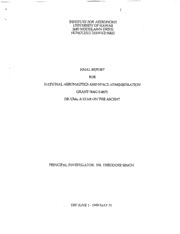
NASA Technical Reports Server (NTRS) 20010016105: DK UMa: A Star on the Ascent PDF
Preview NASA Technical Reports Server (NTRS) 20010016105: DK UMa: A Star on the Ascent
_v INSTITUTE FOR ASTRONOMY UNWERSITY OF HAWAII 2680 WOODLAWN DRIVE HONOLULU HAWAII 96822 FINAL REPORT FOR NATIONAL AERONAUTICS AND SPACE ADMINISTRATION GRANT NAG 5-4631 DK UMa, A STAR ON THE ASCENT PRINCIPAL INVESTIGATOR: DR. THEODORE SIMON 1997 JUNE 1 - 1999 MAY 31 I. Papers Published Under this Grant Ayres, T. R., Simon, T., Stem, R.A., Drake, S. A., Wood, B. E., and Brown, A. The Coronae of Moderate-Mass Giants in the Hertzsprung Gap and the Clump. 1998, Astrophys. J., 496, 428-448. II. Major Scientific Results DK UMa (= 24 UMa = HD 82210) is a G4 IV-III star. According to its My and B - V color, and as shown in first figure below, it is located at the base of the red giant branch, having recently exited from the Hertzsprung Gap. Now poised to start its first ascent along the giant branch, DK UMa is at a significant juncture in its post-main-sequence evolution, offering an important evolutionary comparison for magnetic activity with stars like 31 Comae, which is just entering the Hertzsprung Gap, and older stars like the Hyades giants or [3Ceti, which have passed the tip of the giant branch and lie in the so-called "clump". As part of a major survey of the ultraviolet and X ray properties of a well-defined sample of evolved giant stars, DK UMa was observed with the Extreme Ultraviolet Explorer (EUVE) spacecraft in March 1997, for a total exposure time of 230 kiloseconds. A plot of the extracted short-wavelength (SW) spectrum of this star is shown in the second figure below (Figure 3 from the Ayres et al. 1998 publication listed in section I above), where it is compared with similar EUVE exposures for other yellow and red giant stars in the activity survey, In terms of the spectral lines of different ionization stages present in these spectra, the transition region and coronal temperature of DK LIMa appears to be intermediate between those of 31 Corn and _ Ceti. Combining the relative strengths of the EUFE lines with HST data at near UV wavelengths and with ROSA T X-ray fluxes, the differential emission measure (DEM) distribu- tions of these stars form a sequence in coronal temperature, which peaks at 107.2K for 31 Corn, at 106.8K for [3Ceti, and at intermediate temperatures for DK UMa - consistent with the evolutionary stages represented by the three stars. The integrated fluxes of the strongest emission lines found in the EUFE spectrum of DK UMa are listed in the table below, which appeared as Table 4 in the Ayres et al. paper, again compared with similar measurements for other giant stars that were observed in the course of other EUFE Guest Observer programs. w' I0 s HR 9024 102 31 • p Cas 10 ® ._J a CMI 24 UMa % % 0.8 " % 0.1 ,,,,I,llll,,,,I,,,,t,,,,I,,,,t,,,,ll,,,I,, 7000 6000 5000 4000 TEFF (K) 1.5 1.0 I I • • • i I i I i i l . i I I I I I I • • • • I I ,_'P.g(F8m-A,)' I : 6 +i + 4 2 0 _'_;-T--.+_=. =+:=_,_,_.+=:+,_'.-°+.=+7"-_,r_+'._.-_ "v-_V.v---r TM ,.I''++"'++.++++'+i+I+ A....t,o I I ,.,.__-,. .... •.... _.......... + _.,_l_.._., , O i+='-.---:-:-: =:_--+':-'_;. i ; , -, -;...,._-;7-_--i-_]-_ =_:"_-4o 'IP" v =--'=' .... ' " ' " 24'UMo (a_t IiI---'lV$ ' " " 'i .... -_6 o _< _< +ii +i + i I1 _!4 _.5:, , ' " ' ' 'A (Gs/o i) ' 1.0 : + _ _i -_ ix+ = i_ 0.5 i+i = +i+ i = a ur 0 IT 0.0 _ ..... i..J..'.._,,._ .... _. -_....It-..... A_^__, ..... I . • I i I , i , _ I I 1.5 L ' ' "_- ' " ' " _._a,.CK0mS.... '; .... / 1.0 0.5 0.0 ........ ;............... "_-'-'-'"-_---%+.I_.-._............... -:"-'---=-"- ...... -,,,.................... T ¢-'-'_ ,'-_ :4 1O0 150 200 250 300 350 WAVELENGTH (_t) Fig. 3.-- EUVE spectra of selected stars, depicted in normalized flux density (corrected for interstellar absorption). Shading indicates +2 _ photometric errors. SW and MW spectra were spliced at 180 It. Important features are identified explicitly: unadorned Roman numerals indicate ionization stages of iron. Table4. EUVE LineFlux Measurements v Peg 31 Corn 24 UMa /_ Cet ID AL h (/_) (10 -13 ergs cm -_ s-1) Short Wavelength Spectrometer (70-190 _) Fe XVIII 93.9 0.30::k 0.09 0.404- 0.08 0.82+ 0.09 2.44- 0.1 Fe XVIII 103.9 0.27 4-0.08 £ 0.2 0.30 4- 0.06 0.90 + 0.10 Fe XIX 108.4 0.26 4- 0.06 0.40 + 0.06 0.44 4- 0.07 2.04-0.1 Fe XXII 117.2 £ 0.2 0.70 4- 0.08 0.33 + 0.08 0.70 4- 0.10 Fe XX 118.7 £ 0.2 0.33 + 0.07 £ 0.2 0.54 4- 0.09 Fe XIX 120.0 £ 0.2 £ 0.2 £ 0.2 0.64 4- 0.10 Fe XX 121.8 £ 0.2 0.414- 0.08 0.24 4- 0.08 0.93 4- 0.10 Fe XXI 128.7 0.28 4- 0.09 0.56 4- 0.09 0.42+ 0.08 1.2 4- 0.1 Fe XXIII/XX 132.8 0.41 4- 0.10 1.6 4- 0.1 0.95 ::k0.11 2.4 ± 0.2 Fe XXII 135.8 £ 0.3 0.62 4- 0.11 £ 0.2 0.71 4- 0.13 Fe IX 171.1 _ 0.7 £ 0.7 _ 0.7 £ 0.8 Fe X 174.5 £ 0.9 _ 0.8 £ 0.8 £ 1.0 Fe X 177.2 £ 1.1 £ 0.9 £ 0.9 £ 1.3 Fe XI/X 180.4 £ 1.3 £ 1.4 £ 1.4 £ 1.9
